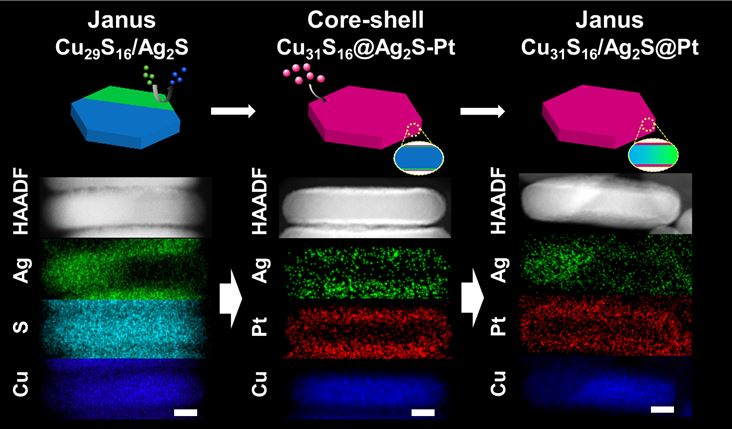
김태경, 박종식, 홍용주 / 공동 제 1저자
Nanocrystals with multiple compositions and hetero-interfaces have received a great attention due to promising multifunctional and synergistic physicochemical properties. In particular, hetero-interfaces have been at the focal point of nanocatalyst research because the strain caused by lattice mismatches between different phases is the dominant determinant of surface energy and catalytic activity. The ensemble effects of different materials phases have also contributed to the interest in hetero-interfaced multicomponent materials. Until now, hetero-interfaces have largely been regarded as static and the dynamic movement of components within the multicomponent material phases has received little attention, although the dynamic movement of individual components within multicomponent materials can revise the interpretation of the catalytic behaviors of these materials and lead to fascinating opportunities for nanostructure synthesis. In this study, we demonstrate unprecedented cation migrations within a sulfide matrix induced by surface strain modulation initiated by cation exchange. Specifically, Cu and Ag cations in the sulfide matrix were initially segregated to form a Janus structure. This Janus configuration was then transformed into a core-shell Cu2-xS@Ag2S structure via surface Pt doping. When the surface strain was relieved by a reduced Pt concentration at the nanoparticle surface, the core-shell transitioned back into a Janus structure. We expect that the facile composition fluctuations in multiphasic nanostructures will expand synthetic methodologies for the design and synthesis of intricate nanostructures with useful physicochemical properties.

 A Hydrogen-Bonded Organic Framework with Type IV NH3 Adsorpti...
A Hydrogen-Bonded Organic Framework with Type IV NH3 Adsorpti...
 Two Different Length-Dependent Regimes in Thermoelectric Larg...
Two Different Length-Dependent Regimes in Thermoelectric Larg...

















